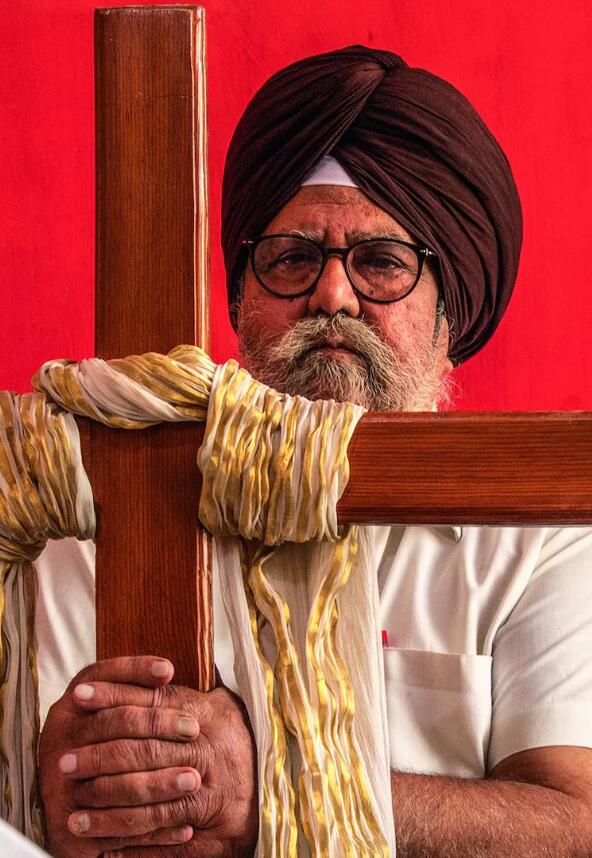BJP spokesperson R.P. Singh recently made a statement that has stirred an honest nest — Christian conversion in Punjab. He said that the Shiromani Gurdwara Parbandhak Committee, which manages Sikh gurdwaras, could soon become the “Shiromani Christian Committee.” While a section is creating a hue and cry over his remarks, it must be taken seriously as it highlights the increasing Christian conversions in Punjab led by Christian missionaries who lure people from village to village and convert them illegally.
Punjab is the same land where the Sikh gurus – Guru Tegh Bahadur, Guru Gobind Singh, and his four sons sacrificed their lives but did not leave their faith. Unfortunately today, many people coming from Sikh families have accepted Christianity as their religion and are now involved in encouraging further conversions. According to the 2011 census, Christians constituted 1.26% of Punjab’s population. However, experts estimate that Christians now make up about 15% of the state’s population, revealing a stark gap between government data and the ground reality.
Most recently, during the 2022 assembly elections, some people from Punjab started calling themselves Dalit Christians which gave credence to the efforts made towards conversion. It is said that many of these Dalit Christians were actually converted by Christian missionaries.
In 2022, the then Jathedar of Akal Takht, Giani Harpreet Singh went a step further and demanded an anti-conversion law while stating that Christian missionaries were attempting to force Sikhs into Christianity using fake miracles and deceitful practices. Singh said that although he has expressed concerns about “foreign forces” that fund the conversion of poor Sikhs and Hindus in Punjab, the state has not taken action due to vote bank politics.
The report states that active missionaries are converting Hindus and Sikhs within Punjab and the success of these conversion strategies is evident during Sunday prayer meetings which see heavy attendance as people arrive in thousands of numbers on bikes, cars, and rented buses to churches located in khambra village, Jalandhar. An investigation carried out by India Today targeted Pastor Ankur Narula as the driving force of the activity.
Having been raised Hindu Khatri, Narula converted to Christianity in 2008, later establishing “Ankur Narula Ministry” and ‘Church of Science and Wonders’. His following grew from merely three converts to over 300,000 in a span of 16 years. He is allegedly building the largest church in Asia. His ‘conversion empire’ covers over 65 acres in Khambra village, with further bases established in nine other districts in Punjab, Bihar, Bengal, and countries such as the USA, Canada, Germany, and the UK.
However, it is worth mentioning that the conversion may not be limited to Jalandhar and the neighboring villages. There have been similar reports about the church in Sehansara Kalan village in Amritsar, a city that is noted as the most sacred place of Sikhs because of its Golden Temple. Pastor Gurunam Singh, a police officer, conducts Sunday prayers there, though he maintains that he only offers prayers, despite questions on how attendees eventually convert to Christianity.
Punjab is not new to Christian conversion efforts. Historically, Christian missionaries successfully converted the last Sikh king, Maharaja Duleep Singh. Today, prominent pastors like Amrit Sandhu, Raman Hans, Gurnam Singh Khera, Kanchan Mittal, and others are central to the conversion drive, with influence across social media and large followings on platforms like YouTube. These leaders hold esteemed positions as doctors, engineers, lawyers, and businessmen, while some have left their professions to focus on conversion activities.
The Open Door Church in Kapurthala, led by Harpreet Deol, and another church led by Pastor Gurnam Singh Khera, are just two examples where prominent Sikhs lead Christian congregations. These “turbaned Christians” highlight a trend where individuals from diverse professions are leading congregations and actively encouraging conversions.
Christian missionaries are particularly active in Punjab’s border areas of Ferozepur and Fazilka and the Majha and Doaba belts. India Today reports that Punjab has close to 65,000 pastors. The United Christian Front also notes that out of Punjab’s 12,000 villages, 8,000 have Christian religious committees, and there are about 600–700 churches in the Amritsar and Gurdaspur districts. Remarkably, around 70% of these churches have been established in the last five years, pointing to the rapid expansion of the Christian faith in the region.
Punjab’s current situation parallels that of southern states like Tamil Nadu and Kerala in the 1980s and 1990s. However, the Shiromani Gurdwara Parbandhak Committee (SGPC) president, Harjinder Singh Dhami, appears less concerned, suggesting that people seeking solutions from pastors will eventually return to their original faith. Still, campaigns like “Ghar Ghar Andar Dharamsaal,” where Sikh volunteers go door-to-door to reinforce Sikh values, underscore the escalating nature of the situation.
As conversions rise, many wonder how these “turbaned Christians” emerged in Punjab. Concerns grow about the government’s role and whether those driving the conversion trend are merely beneficiaries of vote-bank politics. The longer these questions remain unanswered, the stronger the influence of the “conversion mafia” in Punjab will become, potentially reshaping the region’s religious landscape.
